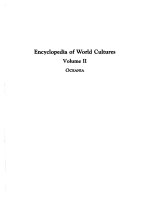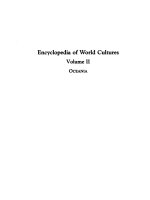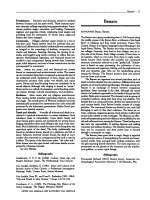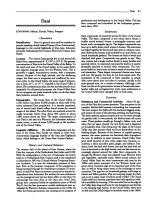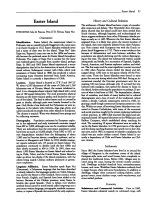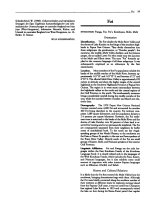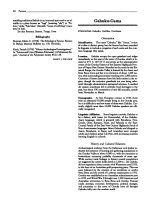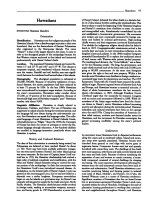Encyclopedia of World Cultures Volume 2 - Oceania - H,I docx
Bạn đang xem bản rút gọn của tài liệu. Xem và tải ngay bản đầy đủ của tài liệu tại đây (703.68 KB, 6 trang )
Hawaiians
95
Hawaiians
ETHNONYM:
Hawaiian
Islanders
Orientation
Identification.
Hawaiians
are
the
indigenous
people
of
the
Hawaiian
Islands.
Now
a
disadvantaged
minority
in
their
own
homeland,
they
are
the
descendants
of
Eastern
Polynesians
who
originated
in
the
Marquesas
Islands.
The
name
'Hawai'i"
is
that
of
the
largest
island
in
the
chain.
It
came
to
refer
to
the
aboriginal
people
of
the
archipelago
because
the
first
Western
visitors
anchored
at
that
island
and
interacted
predominantly
with
Hawai'i
Island
chiefs.
Location.
The
populated
Hawaiian
Islands
are
located
be-
tween
15°
and
200
N
and
160°
and
1550
W.
The
climate
is
temperate
tropical,
and
weathered
volcanic
features
domi-
nate
the
terrain.
Rainfall
and
soil
fertility
may
vary
signifi-
candy
between
the
windward
and
leeward
sides
ofthe
islands.
Demography.
The
aboriginal
population
is
estimated
at
250,000-300,000.
Because
of
recurrent
epidemics
of
intro-
duced
diseases,
the
native
population
had
been
reduced
by
at
least
75
percent
by
1854.
In
the
late
1880s
Hawaiians
were
outnumbered
by
immigrant
sugar
workers.
According
to
the
state's
enumeration,
Hawaiians
today
number
about
175,000,
or
19
percent
of
the
state's
population.
Because
of
historically
high
rates
of
Hawaiian
exogamy
'pure'
Hawaiians
number
only
about
9,000.
Linguistic
Affiliation.
Hawaiian
is
closely
related
to
Marquesan,
Tahitian,
and
Maori.
The
use
of
Hawaiian
was
suppressed
in
island
schools
during
the
territorial
period,
and
the
language
fell
into
disuse
during
the
mid-twentieth
cen-
tury.
Few
Hawaiians
can
speak
the
language
today.
The
collo-
quial
language
of
most
Hawaiians
is
Hawai'i
Islands
Creole,
informally
known
as
"Pidgin."
Since
the
1970s
the
University
of
Hawaii
has
been
the
center
of
attempts
to
revive
the
Ha-
waiian
language
through
education.
A
few
hundred
children
are
enrolled
in
language-immersion
preschools
where
only
Hawaiian
is
spoken.
History
and
Cultural
Relations
The
date
of
first
colonization
is
constantly
being
revised,
but
Polynesians
are
believed
to
have
reached
Hawai'i
by
about
AD.
300.
There
may
have
been
multiple
settlement
voyages,
but
two-way
travel
between
Hawai'i
and
other
island
groups
was
never
extensive.
By
the
time
of
Captain
James
Cook's
ar-
rival
late
in
1778,
the
Hawaiian
chieftainship
had
evolved
a
high
order
of
political
complexity
and
stratification,
with
the
Maui
and
Hawai'i
Island
dynasties
vying
to
control
the
east-
ern
portion
of
the
archipelago.
In
their
first
encounters
with
the
Hawaiians
Cook's
men
introduced
venereal
disease.
At
Kealakekua,
on
the
leeward
side
of
Hawai'i
Island,
Cook
was
greeted
as
the
returning
god
Lono,
but
he
was
later
killed
in
a
skirmish
over
a
stolen
longboat.
Europeans
nevertheless
began
to
use
the
islands
as
a
provisions
stop,
for
Hawai'i
was
uniquely
well
situated
to
supply
the
fur
trade
and,
later,
North
Pacific
whalers.
The
Hawaiian
chiefs
became
avidly
involved
in
foreign
trade,
seeking
to
accumulate
weapons,
ammuni-
tion,
and
luxury
goods.
In
1795
Kamehameha,
a
junior
chief
of
Hawai'i
Island,
defeated
the
Maui
chiefs
in
a
decisive
bat-
tie
on
O'ahu
Island,
thereby
unifying
the
windward
isles.
This
date
is
taken
to
mark
the
beginning
of
the
Hawaiian
kingdom
and
Hawai'i's
transition
from
chiefdom
to
state.
An
astute
and
strong-willed
ruler,
Kamehameha
consolidated
his
rule
and
established
a
bureaucratic
government.
His
successors
were
weaker
and
were
continually
pressured
by
foreign
resi-
dents
and
bullied
by
colonial
governments.
High-ranking
chiefly
women
and
their
supporters
convinced
Kamehameha
11
to
abolish
the
indigenous
religion
shortly
after
his
father's
death
in
1819.
Congregationalist
missionaries
arrived
a
few
months
later
and
came
to
exert
tremendous
influence
on
the
kingdom's
laws
and
policies.
In
the
1840s
resident
foreigners
persuaded
Kamehameha
III
to
replace
the
traditional
system
of
land
tenure
with
Western-style
private
landed
property.
The
resulting
land
division,
the
'Great
Mihele,"
was
a
disas-
ter
for
the
Hawaiian
people.
The
king,
the
government,
and
major
chiefs
received
most
of
the
land,
with
only
29,000
acres
going
to
80,000
commoners.
At
the
same
time
foreigners
were
given
the
right
to
buy
and
own
property.
Within
a
few
decades
most
Hawaiians
were
landless
as
foreign
residents
ac-
cumulated
large
tracts
for
plantations
and
ranches.
The
1875
Reciprocity
Treaty
with
the
United
States
ensured
the
profit-
ability
of
sugar.
Planters
imported
waves
of
laborers
from
Asia
and
Europe,
and
Hawaiians
became
a
numerical
minority.
A
clique
of
white
businessmen
overthrew
the
last
monarch,
Queen
Lili'uokalani,
in
1893.
Although
President
Grover
Cleveland
urged
that
the
monarchy
be
restored,
Congress
took
no
action
and
annexation
followed
in
1898.
While
de-
scendants
of
the
Asian
sugar
workers
have
lived
the
Ameri-
can
dream
in
Hawai'i,
native
Hawaiians
suffered
increasing
poverty
and
alienation
during
the
territorial
period.
Hawaiian
radicalism
and
cultural
awareness
have
been
on
the
upsurge
since
the
mid-1970s.
Citing
the
precedent
of
American
In-
dian
tribal
nations,
activists
now
demand
similar
status
for
Hawaiians,
and
the
movement
for
Hawaiian
sovereignty
has
gained
increasing
credibility
among
the
state's
political
leaders.
Settlements
In
precontact
times
Hawaiians
lived
in
dispersed
settlements
along
the
coasts
and
in
windward
valleys.
Inland
and
moun-
tain
areas
were
sparsely
populated.
Hawaiian
houses
were
thatched
from
ground
to
roof
ridge
with
native
grass
or
sugarcane
leaves.
Commoner
houses
were
low
and
sparsely
furnished
with
coarse
floor
mats.
The
dwellings
of
the
chiefs
were
more
spacious,
with
floors
and
walls
covered
thickly
with
fine
mats
and
bark
cloth.
Because
of
taboos
mandating
the
separation
of
men
and
women
in
certain
contexts,
a
house-
hold
compound
consisted
of
several
dwellings
for
sleeping
and
eating.
The
most
important
developments
affecting
Ha-
waiians
since
the
mid-nineteenth
century
have
been
land
al-
ienation
and
urbanization.
Small
Hawaiian
subsistence
com-
munities
practicing
fishing
and
farming
persist
in
isolated
rural
areas
of
Maui,
Moloka'i,
and
Hawai'i.
On
O'ahu,
the
leeward
Waianae
coast
is
a
center
of
Hawaiian
settlement.
Significant
numbers
of
Hawaiians
also
live
on
leased
house
lots
in
government-sponsored
Hawaiian
Home
Lands
com-
munities
within
the
city
of
Honolulu.
Dwellings
in
the
style
of
plantation
housing
predominate
in
working-class
communi-
ties
and
neighborhoods
throughout
Hawai'i,
and
Hawaiian
settlements
are
no
exception
to
this
pattern.
In
most
Hawai-
ian
villages
and
neighborhoods
the
houses
are
of
single,
walled
wood
construction,
sometimes
raised
off
the
ground
on
pilings,
with
corrugated
iron
roofs.
Rural
Hawaiians
may
have
small
houses
for
cooking
and
bathing
behind
the
main
dwelling,
a
pattern
that
appears
to
be
a
holdover
from
Polyne-
sian
culture.
Economy
Substence
and
Commercial
Activines.
The
first
Poly-
nesian
settlers
in
Hawai'i
subsisted
largely
on
marine
re-
sources.
In
the
ensuing
centuries
the
Hawaiians
developed
extensive
and
highly
productive
agricultural
systems.
The
sta-
ple
food
was
taro,
a
starchy
root
that
the
Hawaiians
pounded
and
mashed
into
a
paste
called
poi.
In
wetland
valleys
taro
was
grown
in
irrigated
pond
fields
resembling
rice
paddies.
Intricate
networks
of
ditches
brought
water
into
the
taro
patches,
some
of
which
doubled
as
fish
ponds.
In
the
late
precontact
period,
concurrent
with
increasing
political
com-
plexity,
large
walled
fish
ponds
were
constructed
in
offshore
areas.
These
were
reserved
for
chiefly
use.
The
lee
sides
of
the
islands
supported
extensive
field
systems
where
Hawaiians
grew
dry-land
taro,
sweet
potatoes,
breadfruit,
and
bananas.
The
Polynesians
brought
pigs,
dogs,
and
chickens
to
Hawai'i.
Goats
and
cattle
were
introduced
by
Westerners
before
1800.
In
the
early
1800s,
to
avoid
the
chiefs'
growing
demands
on
the
rural
populace,
some
Hawaiians
turned
to
seafaring,
ped-
dling,
and
various
jobs
in
the
ports.
The
shift
from
rural
sub-
sistence
to
wage
labor
intensified
in
the
latter
half
of
the
cen-
tury.
Hawaiians-men
and
women-made
up
the
bulk
of
the
sugar
plantation
labor
force
until
after
1875.
According
to
1980
state
figures,
about
23
percent
of
Hawaiians
today
are
employed
in
agriculture.
Some
are
independent
small
farmers
who
produce
the
traditional
staple,
taro,
for
sale
to
markets.
But
most
Hawaiians
are
engaged
in
service
jobs.
Hawaiians
are
underrepresented
in
management
and
professional
occu-
pations
and
overrepresented
as
bus
drivers,
police
officers,
and
fire
fighters.
Industrial
Arts.
Indigenous
Hawaiian
crafts
included
mat
and
bark-cloth
making,
feather
work,
and
woodworking.
Trade.
Although
the
traditional
Hawaiian
local
group
was
largely
self-sufficient,
there
was
specialization
and
internal
trade
in
canoes,
adzes,
fish
lines,
salt,
and
fine
mats.
In
the
postcontact
period
Hawaiians
have
tended
to
leave
store
keeping
and
commerce
to
other
ethnic
groups.
Division
of
Labor.
Most
agricultural
labor
was
performed
by
men
in
ancient
Hawai'i,
as
was
woodworking
and
adz
man-
ufacture.
Women
made
bark
cloth
for
clothing
and
mats
for
domestic
furnishings,
chiefly
tribute,
and
exchange.
Men
did
the
deep-sea
fishing
while
women
gathered
inshore
marine
foods.
In
most
Hawaiian
families
today
both
spouses
have
salaried
jobs
outside
the
home.
Land
Tenure.
In
the
native
Hawaiian
conception
land
was
not
owned
but
"cared
for."
Use
and
access
rights
were
al-
located
through
the
social
hierarchy
from
the
highest
chiefs
to
their
local
land
supervisors
and
thence
to
commoners.
The
most
important
administrative
unit
was
a
land
section
called
the
ahupua'a,
which
ideally
ran
from
the
mountain
to
the
sea
and
contained
a
full
range
of
productive
zones.
Typically
a
household
had
rights
in
a
variety
of
microenvironments.
The
introduction
of
private
land
titles
resulted
in
widespread
dispossession
in
part
because
Hawaiians
did
not
understand
the
implications
of
alienable
property.
The
lands
of
the
Kamehameha
chiefly
family
descended
to
Princess
Bernice
Pauahi
Bishop,
whose
estate
supports
the
Kamehameha
Schools
in
Honolulu
for
the
education
of
Hawaiian
children.
The
Hawaiian
Home
Lands,
established
by
Congress
in
1920,
are
leased
to
persons
who
can
prove
50
percent
Hawai-
ian
ancestry.
Originally
conceived
as
a
'back
to the
land"
farming
program,
the
Hawaiian
Home
Lands
are
now
used
primarily
for
house
lots.
Kinship
Kin
Groups
and
Descent.
There
were
no
corporate
kin
groups
among
Hawaiians
at
the
time
of
contact.
The
chiefs
could
trace
their
genealogies
back
many
generations
through
bilateral
links,
opportunistically
linking
themselves
to
paric-
ular
ancestral
lines
as
the
political
situation
demanded.
Com-
moners
recognized
shallow
bilateral
kindreds
augmented
by
stipulated
and
fictive
kin.
Kinship
Terminology.
In
the
Hawaiian
language
no
dis-
tinction
is
made
between
parents
and
parents'
collateral
kin.
Same-sex
siblings
are
ranked
by
relative
age,
but
brother
and
sister
are
terminologically
unranked.
Marriage
and
Family
Marriage.
In
pre-Christian
Hawai'i
both
sexes
enjoyed
near-complete
freedom
to
initiate
and
terminate
sexual
at-
tachments.
Marriage
was
unmarked
by
ceremony
and
was
hardly
distinguished
from
cohabitation
and
liaisons,
except
in
chiefly
unions.
The
birth
of
children
was
the
more
impor-
tant
ceremonial
occasion.
Marrying
someone
of
higher
rank
was
the
ideal
for
both
men
and
women.
Polygyny
was
the
norm
among
the
ruling
chiefs,
permissible
but
infrequent
among
the
common
people.
Postmarital
residence
was
deter-
mined
by
pragmatic
considerations.
Domestic
Unit.
Both
commoners
and
chiefs
lived
in
large
extended-family
household
groups
with
fluid
composition.
The
indigenous
religion
mandated
that
men
and
women
had
to
have
separate
dwelling
houses
and
could
not
eat
together.
Inheritance.
Men
were
more
likely
to
inherit
land
rights
than
women,
while
women
were
privileged
in
the
inheritance
of
the
family's
spiritual
property
and
knowledge.
Since
the
legal
changes
of
the
nineteenth
century
land
inheritance
among
Hawaiians
has
been
mostly
bilateral.
Socialization.
In
Hawaiian
families
today
grandparents
have
an
especially
close
relationship
with
their
grandchildren,
and
they
frequently
take
over
parenting
duties.
As
in
other
Polynesian
societies,
children
may
be
adopted
freely
without
emotional
turmoil
or
secretiveness.
Emphasis
is
placed
on
re-
spect
for
age
and
mutual
caring
between
family
members.
Sociopolitical
Organization
At
the
time
of
Western
contact
in
1778
the
Hawaiian
islands
were
politically
divided
into
several
competing
chiefdoms.
Hawai'i
was
an
independent
kingdom
from
1795
to
1893
and
a
United
States
territory
from
1898
until
statehood
in
1959.
Social
Organization.
Precontact
Hawai'i
was
a
highly
stratified
society
where
the
chiefs
were
socially
and
ritually
set
A
Hawaiians
97
apart
from
the
common
people.
Rank
was
bilaterally
deter-
mined
and
chiefly
women
wielded
considerable
authority.
The
commoner
category
was
internally
egalitarian.
Political
Organizatio.
Each
island
was
divided
into
dis-
tricts
consisting
of
several
ahupua'a
land
sections.
Districts
and
ahupua'a
were
redistributed
by
successful
chiefs
to
their
followers
after
a
conquest.
The
chief
then
appointed
a
local
land
agent
to
supervise
production
and
maintenance
of
the
irrigation
system.
The
commoners
materially
supported
the
chiefs
with
tribute
at
ritually
prescribed
times.
Rebellions
and
power
struggles
were
common.
In
legendary
histories
cruel
and
stingy
chiefs
are
deserted
by
their
people
and
overthrown
by
their
kinder
younger
brothers.
Social
Control.
The
chiefs
had
absolute
authority
over
commoners.
They
could
confiscate
their
property
or
put
them
to
death
for
violating
ritual
prohibitions.
In
practice,
how-
ever,
chiefs
were
constrained
by
their
reliance
on
the
underly-
ing
populace
of
producers.
In
Hawaiian
communities
today
there
is
no
sense
of
inborn
rank
and
an
egalitarian
ethic
pre-
vails.
Pretensions
are
leveled
by
the
use
of
gossip
and
tempo-
rary
ostracism.
Conflict.
Warfare
was
endemic
in
the
Hawaiian
chieftain-
ship
in
the
century
or
two
preceding
Cook's
arrivaL
After
Kamehameha's
conquest
the
Hawaiian
warrior
ethic
declined
to
the
extent
that
the
monarchy
could
be
overthrown
in
1893
by
a
company
of
marines.
Interpersonal
conflicts
among
Ha-
waiians
today
typify
the
tensions
present
in
any
small-scale
community,
and
they
are
for
the
most
part
resolved
through
the
intervention
of
family
and
friends.
Hawaiians
are
very
re-
luctant
to
call
in
outside
authorities
to
resolve
local-level
conflicts.
Religion
and
Expressive
Culture
The
religion
described
in
ethnohistorical
sources
was
largely
the
province
of
male
chiefs.
Sacrificial
rites
performed
by
priests
at
monumental
temples
served
to
legitimate
chiefly
authority.
Religious
Beliefs.
Chiefs
were
genealogically
linked
to
gods
and
were
believed
to
have
sacred
power
(mana).
Under
what
was
called
the
kapu
system
women
were
denied
many
choice
foods
and
could
not
eat
with
men.
Pre-Christian
be-
liefs
persisted
at
the
local
level
long
after
the
chiefly
sacrificial
religion
was
overthrown.
The
indigenous
religion
recognized
four
major
gods
and
at
least
one
major
goddess
identified
with
the
earth
and
procreation.
Ku,
the
god
of
war,
fishing,
and
other
male
pursuits,
was
Kamehameha's
patron
deity.
Another
god,
Lono,
represented
the
contrasting
ethos
of
peace
and
reproduction.
Women
worshipped
their
own
pa-
tron
goddesses.
Commoners
made
offerings
to
ancestral
guardian
spirits
at
their
domestic
shrines.
Deities
were
also
associated
with
particular
crafts
and
activities.
Although
Congregationalists
were
the
first
to
missionize
in
Hawai'i,
the
sect
has
few
adherents
among
Hawaiians
today.
Roman
Ca-
tholicism
has
attracted
many
Hawaiians,
as
have
small
Prot-
estant
churches
emphasizing
personal
forms
of
worship.
Religious
Practitioners.
Before
the
kapu
abolition
younger
brothers
normatively
served
their
seniors
as
priests.
Major
deities
had
their
own
priesthoods.
The
volcano
god-
dess
Pele
is
said
to
have
had
priestesses.
Among
the
common-
ers
there
were
experts
in
healing
and
sorcery,
known
as
'Kihuna,"
and
such
specialists
are
still
utilized
by
Hawaiians
today.
Ceremonies.
The
Hawaiian
ritual
calendar
was
based
on
lunar
phases.
Ku
ruled
the
land
for
eight
months
of
the
year.
Lono
reigned
for
four
winter
months
during
the
Makahihd
fes-
tival
when
warfare
was
suspended
and
fertility
was
celebrated.
Arts.
Chiefly
men
were
sometimes
tattooed,
but
this
was
not
a
general
custom
and
most
of
the
details
have
been
lost.
The
carved
wooden
idols
of
the
gods
are
artistically
impres-
sive,
but
few
survived
the
dramatic
end
of
the
native
religion.
The
hula,
the
indigenous
dance
form,
had
numerous
styles
ranging
from
sacred
paeans
to
erotic
celebrations
of
fertility.
Various
percussion
instruments
used
induded
drums,
sticks,
bamboo
pipes,
pebbles
(like
castanets),
gourds,
rattles,
and
split
bamboo
pieces.
Medicine.
Hawaiians
today
utilize
Western
medicine
but
may
also
consult
healers
and
spiritual
specialists,
some
linked
to
Hawaiian
cultural
precedent
and
others
syncretic,
drawing
on
other
ethnic
traditions.
Hawaiians
are
particularly
prone
to
spirit
possession,
and
many
believe
that
evil
thoughts
have
material
consequences
on
other
people.
Illness
is
linked
to
so-
cial
grievances
or
imbalances.
Death
and
Afterlife.
Ancient
Hawaiians
secreted
remains
of
the
dead
in
burial
caves.
The
deceased's
personal
power
or
mana
was
believed
to
reside
in
the
bones.
Chiefs
were
particu-
larly
concerned
that
their
enemies
not
find
their
remains
and
show
disrespect
to
them
after
death.
Those
who
broke
the
ta-
boos,
on
the
other
hand,
were
killed
and
offered
to
the
gods,
and
their
remains
were
allowed
to
decompose
on
the
temple.
See
also
Marquesas,
Tahiti
Bibliography
Kirch,
Patrick
V.
(1985).
Feathered
Gods
and
Fishhooks:
An
Introduction
to
Hawaiian
Archaeology
and
Prehistory.
Honolulu:
University
of
Hawaii
Press.
Kuykendall,
Ralph
S.
(1938).
The
Hawaiian
Kingdom.
Vol.
1,
1778-1854.
Honolulu:
University
of
Hawaii
Press.
Linnekin,
Jocelyn
(1985).
Children
of
the
Land:
Exchange
and
Status
in
a
Hawaiian
Community.
New
Brunswick,
N.J.:
Rutgers
University
Press.
Valeri,
Valerio
(1985).
Kingship
and
Sacrifice:
Ritual
and
Soci-
ety
in
Ancient
Hawaii.
Chicago:
University
of
Chicago
Press.
JOCELYN
LINNEKIN
98
larmul
latmul
ETHNONYM:
Yatmul
Orientation
Identification.
The
latmul
live
along
the
banks
of
the
Middle
Sepik
River
in
the
East
Sepik
Province
of
Papua
New
Guinea.
Location.
The
Middle
Sepik
area
is
dominated
by
the
me-
andering
river
that
regularly
floods
the
whole
valley
and
con-
tinuously
changes
its
course
as
it
flows
from
west
to
east
into
the
Bismarck
Sea.
During
the
wet
season,
extremely
heavy
rains
raise
the
water
level
4-6
meters,
turning
the
whole
re-
gion
into
a
lake
that
extends
far
into
the
northern
grasslands
(turning
them
into
swamp)
and
to
the
Sepik
Hills
in
the
south.
Floating
grass
islands,
sometimes
with
whole
trees
and
birds
on
them,
are
typical
for
that
season
as
the
rising
flood-
waters
tear
off
parts
of
riverbanks
and
carry
them
downstream
until
they
get
stuck
somewhere
else.
latmul
territory
begins
about
230
kilometers
up
from
the
mouth
of
the
Sepik
and
ends
about
170
kilometers
farther
upstream.
The
latmul
lead
an
almost
amphibian
way
of
life
within
the
two
main
seasons,
wet
and
dry,
each
lasting
for
five
months
with
two
intermedi-
ate
months
in
between.
Demography.
The
latmul
number
about
10,000,
and
clas-
sify
themselves
into
three
territorial
subgroups:
eastern
(Wo-
liagui),
central
(Palimbei),
and
western
(Nyaura).
During
the
last
few
years
many
latmul
have
left
the
Middle
Sepik,
with
nearly
50
percent
of
the
population
today
living
elsewhere
in
Papua
New
Guinea,
temporarily
or
even
permanently.
There
are
latmul
colonies,
sometimes
of
considerable
size,
in
the
towns
of
Wewak,
Madang,
and
Rabaul
(on
New
Britain).
LUnguistic
Affiliation.
latmul
is
joined
with
Abelam,
Boi-
ken,
Sawos,
and
other
Papuan
languages
in
the
Ndu
Family
of
the
Sepik-Ramu
Phylum.
History
and
Cultural
Relations
The
latmul
believe
that
they
all
originated
from
a
hole
in
the
ground
in
Sawos
(Gaikundi)
territory.
Other
oral
traditions
tell
of
drifting
down
the
river
on
rafts,
having
started
some-
where
in
the
west.
The
Sepik
Basin
is,
from
the
point
of
view
of
geology,
relatively
young,
having
achieved
its
present
char-
acter
around
1,000
years
ago.
The
whole
area
was
flooded
by
the
sea
until
about
5,000
years
ago;
only
gradually,
when
the
coastline
withdrew
until
it
reached
its
present
location,
did
the
alluvial
plains
form
and
marine
conditions
change
to
those
of
fresh
water.
Linguistic
and
archaeological
evidence
suggests
that
the
Ndu
speakers
came
down
into
the
Sepik
Basin
from
a
southern
tributary.
The
Sepik
River
(called
the
Kaiserin-Augusta-Fluss
during
German
colonial
times)
was
a
main
passageway
for
colonial
administrators
traveling
upriver
by
ship.
During
German
rule
the
first
official
Sepik
explora-
tory
expedition
took
place
in
1886,
and
it
was
followed
by
sev-
eral
others.
After
World
War
1,
when
Ambunti
Patrol
Post
was
established,
the
new
Australian
administration
tried
to
suppress
head-hunting.
They
finally
succeeded
in
the
mid-
1930s
by
publicly
executing
convicted
latmul
warriors.
The
pacification
of
the
latmul-a
culture
in
which
much
empha-
sis
was
placed
on
male
aggression
and
head-hunting
raids-
brought
far-reaching
cultural
change
from
the
outside
world.
Iatmul
villages
were
in
continuous
contact
with
neighboring
groups
to
the
north
and
south,
often
in
a
symbiotic
subsist-
ence
relationship
with
the
latmul
trading
turtles
and
fish
in
exchange
for
sago.
The
Sawos
were
regarded
as
nurturing
mothers
in
this
regard.
Women
conducted
the
trade
while
men
were
involved
in
joint
rituals
with
neighboring
groups.
Settlements
latmul
villages,
containing
300-1,000
people,
are
built
high
on
riverbanks.
Villages
often
consist
of
three
distinct
sec-
tions,
with
a
men's
house
in
the
center.
Houses
were
often
built
in
two
rows,
parallel
to
or
at
a
right
angle
to
the
course
of
the
river.
The
men's
house
was
usually
built
in
the
center
of
an
open
space,
the
dancing
ground.
Older
latmul
men's
houses,
which
were
huge
buildings
up
to
20
meters
high
and
40
meters
long,
are
among
the
most
impressive
architectural
achievements
in
New
Guinea.
They
served
as
men's
assembly
houses
in
daily
life
and
as
religious
centers
during
rituals.
The
dancing
ground
contained
a
ceremonial
mound
on
which
heads
were
displayed
when
brought
back
from
a
successful
raid.
Each
section
of
the
tripartite
village
owned
a
long
war
canoe
that
was
a
symbol
of
its
cooperation
during
warfare,
as
was
the
ceremonial
house
for
ritual
life.
The
whole
village
usually
constituted
a
defensive
unit,
whereas
only
a
section
of
it
may
have
made
a
raid
on
an
enemy
village.
A
village
often
was
surrounded
by
fences
and
watchtowers.
Traditionally,
latmul
houses
were
huge
pile
dwellings
with
the
families
of
brothers
living
together
in
one
house.
Clans
are
classified
into
moieties,
a
fact
that
can
be
recognized
in
the
layout
of
the
village
and
the
distribution
of
the
houses
there.
Economy
Subsistence
and
Commercial
Activities.
Traditionally
the
latmul
were
mainly
hunters
and
gatherers,
depending
on
fish
and
sago,
with
horticulture
a
secondary
activity
as
the
gardens
on
riverbanks
are
often
inundated
before
the
root
crops
(yams
and
taro)
are
ripe.
Bananas
and
coconuts
are
reg-
ularly
consumed.
The
hunting
of
game
(wild
pigs,
crocodiles,
and,
rarely,
cassowaries)
is
practiced
only
irregularly.
Fishing
is
mainly
women's
work,
using
hooks,
nets,
and
traps;
when
men
fish
they
use
spears.
Among
women
there
is
an
informal
system
of
redistribution
that
provides
fish
to
women
who
are
unable
to
leave
their
houses
because
of
illness,
menstruation,
childbirth,
or
old
age.
Although
most
latmul
villages
have
sago
stands,
they
have
never
been
productive
enough
to
guar-
antee
a
continuous
supply.
Therefore,
latmul
depend
on
sago
produced
by
Sawos
villages
to
the
north
and
by
some
Sepik
Hills
villages
to
the
south.
Every
few
days
latmul
women
transport
fresh
and
smoked
fish
in
their
canoes
to
market
places,
most
of
which
are
located
in
Sawos
territory.
There,
they
barter
fish
for
sago
with
women
from
bush
villages.
The
women's
trading
expeditions
take
a
full
day
and
are
carried
out
mostly
by
elderly
women
who
are
commissioned
by
younger
women
to
do
the
bartering
for
them.
Industrial
Arts
and
Trade.
Most
latmul
villages
specialize
in
the
production
of
different
kinds
of
goods
that
are
used
for
trading.
Aibom
is
well
known
for
pottery,
which
traditionally
was
traded
for
sago
throughout
the
latmul
area;
today
it is
latmul
99
sold
for
money
as
well.
Chambri,
a
non-latmul
border
village
to
the
south,
specializes
in
firmly
plaited
mosquito
bags
man-
ufactured
by
women.
In
all
Sepik
villages,
where
mosquitoes
and
malaria
are
endemic,
these
bags
are
used
by
entire
fami-
lies
sleeping
in
them
communally.
Tambunum
is
renowned
for
its
plaited
bags,
also
produced
by
women,
with
various
col-
ored
patterns.
latmul
carvings
are
among
the
most
artistic
in
New
Guinea.
Men
began
producing
them
in
large
quantities
when
they
found
early
travelers
and
art
dealers
interested
in
them.
Anthropologists
argue
that
latmul
attained
superiority
and
control
over
their
neighbors
by
being
a
'cultural
factory,"
producing
sacred
artifacts,
spells,
and
knowledge
and
then
exporting
them.
However,
no
reliable
information
confirming
this
can
be
found,
except
for
an
exchange
of
ritual
items
that
must
have
taken
place
in
both
directions
as
indicated
by
Abelam
paintings
collected
by
early
German
explorers
in
latmul
villages.
As
far
as
can
be
determined,
irregular
trading
expeditions
took
place
up
southern
tributaries
and
vice
versa,
with
paint,
edible
earth,
and
bark
used
for
medicinal
purposes
imported
from
these
areas.
Shell
rings,
turtleshell
ornaments,
and
other
valuables
arrived
in
the
Middle
Sepik
through
the
Abelam
and
Sawos
regions
and
also
from
the
upper
regions
of
the
Sepik
River.
Stone
blades
as
well
as
pearlshells
came
from
the
highlands
to
the
south.
Division
of
Labor.
Subsistence
activities,
mainly
the
gath-
ering
of
fish
and
sago,
are
carried
out
by
women.
Men
make
almost
all
implements
used
for
subsistence
(canoes,
paddles,
and
tools
for
sago
production)
except
fish
traps,
nets,
and
bags.
Men
build
the
houses
and
are
also
the
ritual
specialists.
Land
Tenure.
Lagoons
and
the
open
river
are
considered
the
property
of
the
villages.
Clans
own
rights
to
specific
fish-
ing
and
gathering
locales.
Garden
land
is
also
owned
by
clans
or
lineages
and
is
allotted
among
the
male
members
of
the
clan
at
the
end
of
each
flood
season.
Kinship
Kin
Groups
and
Descent.
latmul
patrilineal
clans
(ngaiva)
are
the
organizational
basis
of
the
social
order.
Most
clans
are
organized
into
pairs,
with
one
considered
the
elder
brother
and
the
other
the
younger,
both
tracing
their
origin
to
a
pair
of
brothers
who
are
the
founding
ancestors.
Genealo-
gies
are
important
evidence
of
landownership,
the
right
to
produce
and
possess
ritual
paraphernalia
and
ritual
knowl-
edge,
and
the
right
to
perform
specific
ceremonies.
Clan
membership
also
determines
a
man's
place
within
the
men's
house.
Within
clans
there
exists
a
further
differentiation
into
pairs
of
lineages,
with
the
senior
lineage
having
some
author-
ity
over
the
junior
one.
Kinship
Terminology.
Different
terms
are
used
for
matri-
lateral
and
patrilateral
kin.
In
each
generation
siblings
of
the
same
sex
are
classified
together
as
are
parallel
cousins,
and
in
the
parent's
generation
affinal
relatives
are
addressed
in
terms
used
also
for
consanguineal
kin.
Marriage
and
Family
Marriage.
Three
rules
of
marriage
are
reported:
marriage
with
iai
(father's
mother's
brother's
son's
daughter),
marriage
with
na
(father's
sister's
daughter),
and
sister
exchange.
But,
marriages
with
other
categories
of
women
also
took
place.
In
marriage
ceremonies
the
asymmetric
relationship
between
wife
givers
and
wife
takers
were
acted
out
by
an
unequal
ex-
change
of
goods
(shell
valuables,
classified
as
male,
and
household
goods,
classified
as
female).
Postmarital
residence
was
patrilocal.
Domestic
Unit.
Several
closely
related
nuclear
families
live
together
in
a
single
dwelling.
Each
family
has
its
own
sec-
tion
and
within
it
husbands
and
wives
have
their
separate
compartments.
Cowives
and
wives
of
brothers
are
supposed
to
form
a
corporate
unit
for
daily
subsistence
activities.
Inheritance.
Inheritance
of
land
and
ritual
knowledge
fol-
lows
rules
of
seniority
insofar
as
the
eldest
son
usually
inherits
knowledge,
and
thus
power,
that
his
siblings
are
denied.
In
rare
cases a
daughter
may
become
the
heir
if
a
man
has
no
son.
In
former
times,
the
girl
was
then
initiated
with
the
men.
Later,
her
sons
inherited
the
knowledge
from
her
father.
Socialization.
Growing
up
in
latmul
culture
is
a
gradual
process
of
learning
and
experiencing
tasks
performed
by
adults.
Children
participate
actively
in
the
subsistence
econ-
omy.
The
acquisition
of
a
new
skill
and
the
first
performance
of
a
gender-specific
task
are
celebrated
for
each
girl
and
each
boy
individually.
These
ceremonies,
naven,
were
carried
out
spontaneously
by
the
mother's
brother
and/or
his
wife.
Chil-
dren
spend
much
of
their
time
in
independent
and
autono-
mous
groups.
Girls
grow
gradually
into
women's
roles.
Boys,
on
the
other
hand,
have
to
undergo
an
initiation
which
severs
them
from
the
women's
world
and
forces
them
to
adopt
a
male
life-style.
Sociopolitical
Organization
Social
Or0nization.
Local
organization
mirrors
the
social
division
into
moieties,
with
named
clans
represented
in
many
villages
between
whom
relations
are
traced.
The
moieties
are
classified
into
"sky"
(nyaui)
and
"earth"
(or
"mother,"
hnya-
mei).
Each
moiety
is
responsible
for
carrying
out
the
initia-
tion
for
the
boys
of
the
other;
thus,
boys
get
scarified
by
men
from
the
other
group.
latmul
men
are
classified
also
into
an
age-grade
system,
with
four
to
six
different
degrees,
depend-
ing
on
the
village.
Among
the
eastern
latmul
there
exists
a
second
nonlocalized
moiety
system
that
works
as
a
comped-
tive
exchange
system.
Political
Organization.
The
men's
houses
are
not
only
the
religious
center
of
latmul
life
but
the
political
center
as
well.
There
discussions
are
held
concerning
all
public
matters
on
which
a
decision
has
to
be
made
or
action
taken.
Discussions
are
usually
led
by
influential
men
who
occupy
the
structural
position
of
being
endowed
with
ritual
knowledge,
a
prerequi-
site
for
political
leadership.
Among
men
there
is
considerable
competition
and
rivalry
for
political
leadership.
Speech
mak-
ing
is
an
important
factor
in
the
decision-making
process,
and
oratorical
skill
is
a
necessary
condition
for
leadership.
Speeches
are
delivered
near
the
ceremonial
"chair,"
a
totemic
representation
of
a
founding
ancestor
whose
judgment
is
so-
licited
as
a
warrant
for
the
truth.
Another
means
to
political
leadership
was
to
have
a
reputation
as
a
powerful
sorcerer
or
to
be
talented
as
a
chanter.
Social
ControL
Traditionally,
the
men's
house
was
also
the
center
of
jurisdiction
in
quarrels
between
members
of
different
clans.
Within
a
clan
conflicts
were
settled
by
its
own
influential
men.
Women
had
informal
power
in
social
affairs;
for
example,
a
wife
could
refuse
to
provide
her
husband
with
I
00
latmul
food,
and
in
serious
matters
she
could
call
on
her
own
family,
mainly
her
brothers.
At
the
community
level,
women
were
feared
for
their
supposed
polluting
capacities,
which
were
considered
responsible
at
least
in
part
for
sorcery
and
witchcraft.
Conflict.
Warfare
was
an
important
male
activity
and
head-hunting
was
part
of
the
initiation
rite.
Most
attacks
were
against
other
latmul
villages,
particularly
in
the
east.
Religion
and
Expressive
Culture
Religou
Bell.
The
men's
house
is
a
condensation
of
Iatmul
religion,
and
it
also
reveals
the
connections
between
clans
and
their
founding
ancestors.
In
former
days
the
house
posts
were
beautifully
carved,
depicting
parts
of
clan
mythol-
ogy
and
constituting
thereby
the
foundation
not
only
of
the
house
but,
symbolically,
of
the
whole
society.
The
building
on
the
rectangular
dancing
ground
represented
the
first
grass
is-
land
floating
down
the
Sepik
River
as
it
is
described
in
a
myth
of
world
creation.
At
the
same
time
it
represented
the
first
crocodile,
the
primeval
ancestor
who
emerged
from
the
bot-
tom
of
the
flood.
Today,
the
ground
level
of
the
men's
house
is
used
in
everyday
life
by
initiated
men.
It
contains
slit
gongs,
fireplaces,
and
sitting
platforms
as
well
as
ritual
objects
of
minor
importance.
The
upper
floor
is
used
mainly
for
rituals,
and
the
long
flutes
and
other
sacred
paraphernalia
are
kept
there.
Iatmul
culture
is
rich
in
myths
that
constitute
the
idea-
tional
background
explaining
how
everything
came
into
being.
Myths
in
latmul
culture
are
known
by
many
people
but
only
a
few
know
the
names
of
the
actors
and
of the
places.
Names
range
among
the
highly
valued
secrets
of
clans.
Myths
can
become
reactivated
through
rituals,
whereby
the
primeval
time
becomes
the
present
and
the
dancing
ground
and
the
men's
house
become
the
original
stage.
Religious
Practitioners.
The
latmul
acknowledged
men
and
women
who
gained
personal
status
through
their
knowl-
edge
and
use
of
supernatural
powers
for
healing
and
as
inter-
mediaries
with
the
supernatural
world.
Ceremonies.
The
men's
house
was
the
focus
of
different
types
of
rituals:
initiation,
celebration
of
successful
head-
hunting
raids,
performances
by
masked
figures,
and
celebra-
tions
of
death
ceremonies
for
important
persons.
In
initia-
tions
boys
were
scarified,
receiving
the
distinctive
marks
of
a
crocodile,
the
symbol
of
a
ritually
mature
man.
Arts.
latmul
art
is
well
known
for
its
superb
carvings,
which
were
usually
painted
in
a
curvilinear
style.
Almost
all
art
objects
were
used
in
ritual
contexts
and
only
through
such
use
did
they
receive
meaning.
Also
famous
are
the
skulls
over-
modeled
with
clay
and
then
painted.
Apart
from
such
pre-
servable
artifacts,
latmul
art
consists
of
ephemeral
art,
such
as
body
painting
and
decorations
made
of
leaves,
flowers,
and
feathers.
Medicine.
Illness
and
difficult
childbirths
were
treated
with
spells
designed
to
invoke
the
powers
of
ancestors
or
su-
pernatural
forces
such
as
the
sun
or
moon.
Healing
often
fo-
cused
on
symbolically
casting
off
the
illness.
Death
and
Afterlife.
Legitimation
of
the
present
out
of
the
past
was
accomplished
through
the
preservation
of
relics
(bones)
of
ancestors
and
through
eating
scrapings
from
them.
Death
meant
crossing
the
border
between
the
present
and
the
past.
The
corpse
was
handled
only
by
women.
If
the
deceased
had
been
an
important
man
or
woman,
a
represen-
tational
figure
was
erected
and
his
or
her
merits
displayed.
Occasionally
after
interment
the
skull
was
exhumed,
modeled
over
with
clay,
and
then
installed
during
a
special
ceremony
as
an
influential
ancestor.
Ghosts
of
recently
dead
relatives
are
relevant
in
shamanic
seances
as
mediators
between
the
living
and
the
dead.
See
also
Abelam,
Chambri
Bibliography
Bateson,
Gregory
(1936).
Naven.
Cambridge:
Cambridge
University
Press.
Rev.
ed.
1954.
Stanford:
Stanford
Univer-
sity
Press.
Behrmann,
Walter
(1922).
Im
Strorngebiet
des
Sepik.
Berlin:
A.
Scherl.
Lutkehaus,
Nancy,
et
al.,
eds.
(1990).
Sepik
Heritage:
Tradi-
tion
and
Change
in
Papua
New
Guinea.
Durham,
N.C.:
Caro-
lina
University
Press.
Reche,
Otto
(1913).
"Der
Kaiserin-Augusta-Fluss."
In
Ergeb-
nisse
der
Sfidsee
Expedition
1908-1910,
edited
by
Georg
Thi-
lenius.
II.
Ethnographie;
A.,
Melanesien,
voL
1.
Hamburg:
L.
Friederichsen.
Roesicke,
Adolf
(1914).
"Mitteilungen
Ffiber
Ethnograph-
ische
Ergebnisse
der
Kaiserin-Augusta-Fluss-Expedition."
Zeitschrift
fur
Ethnologie
46:507-522.
BRIGrrTA
HAUSER-SCHAUBLIN
